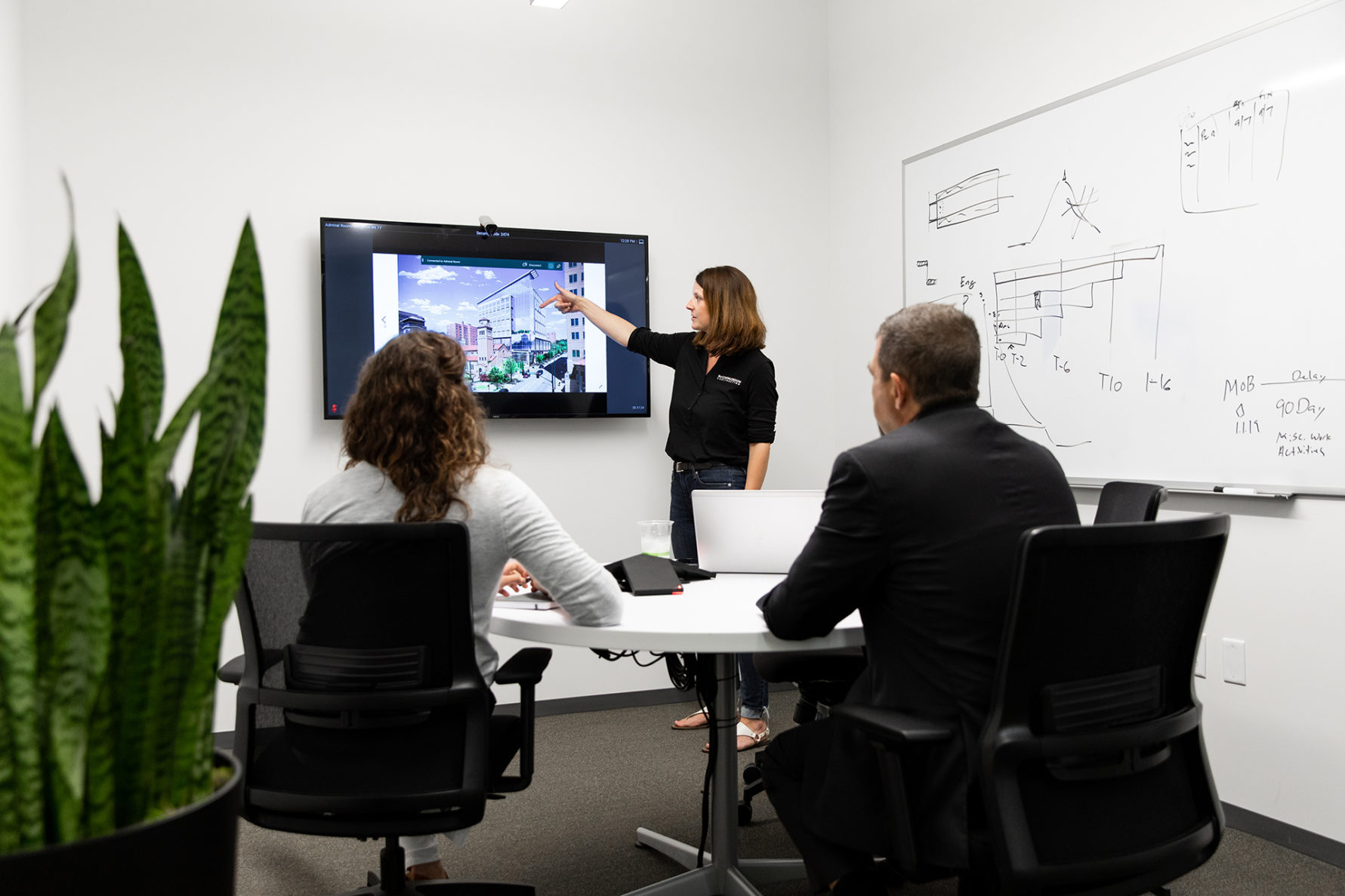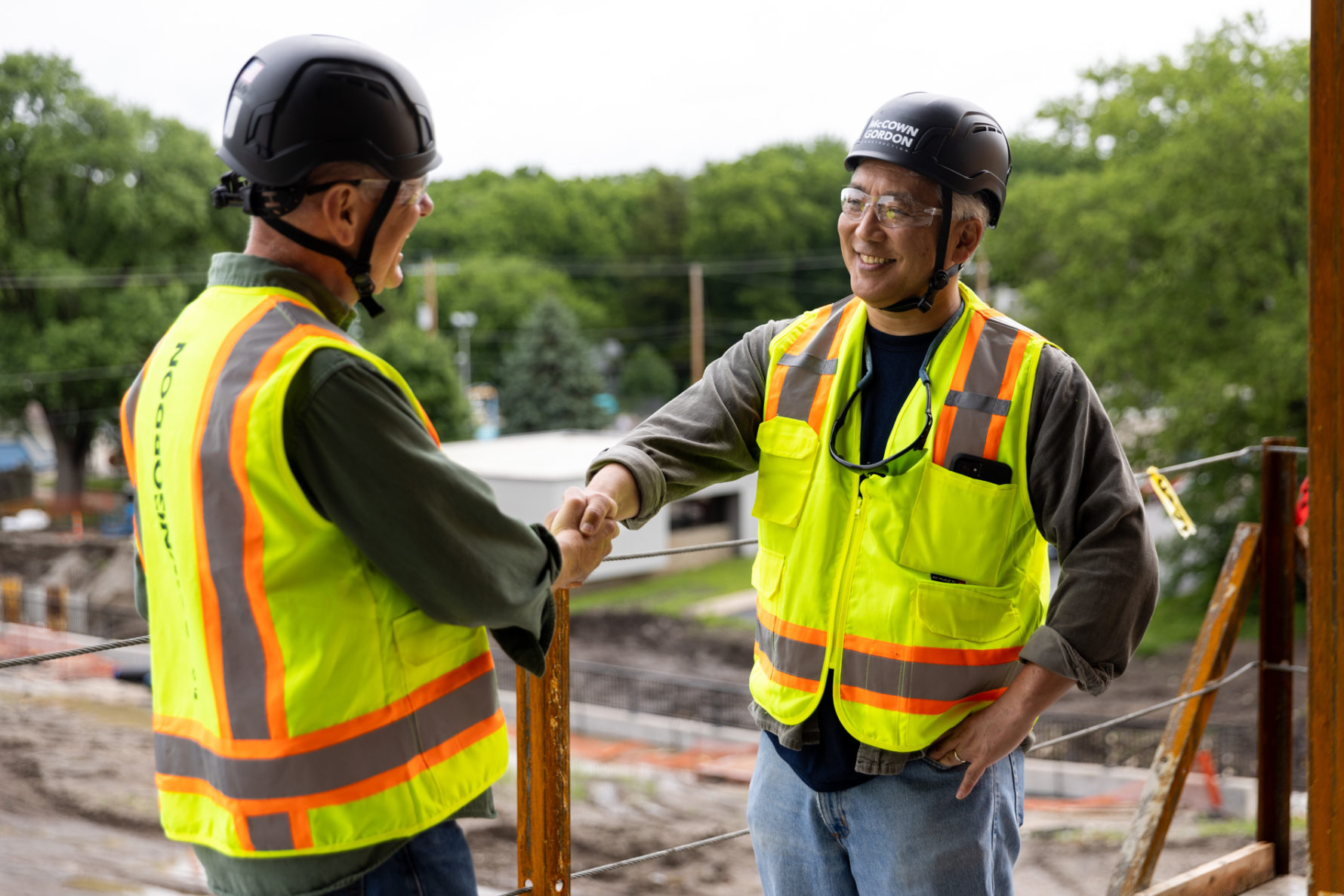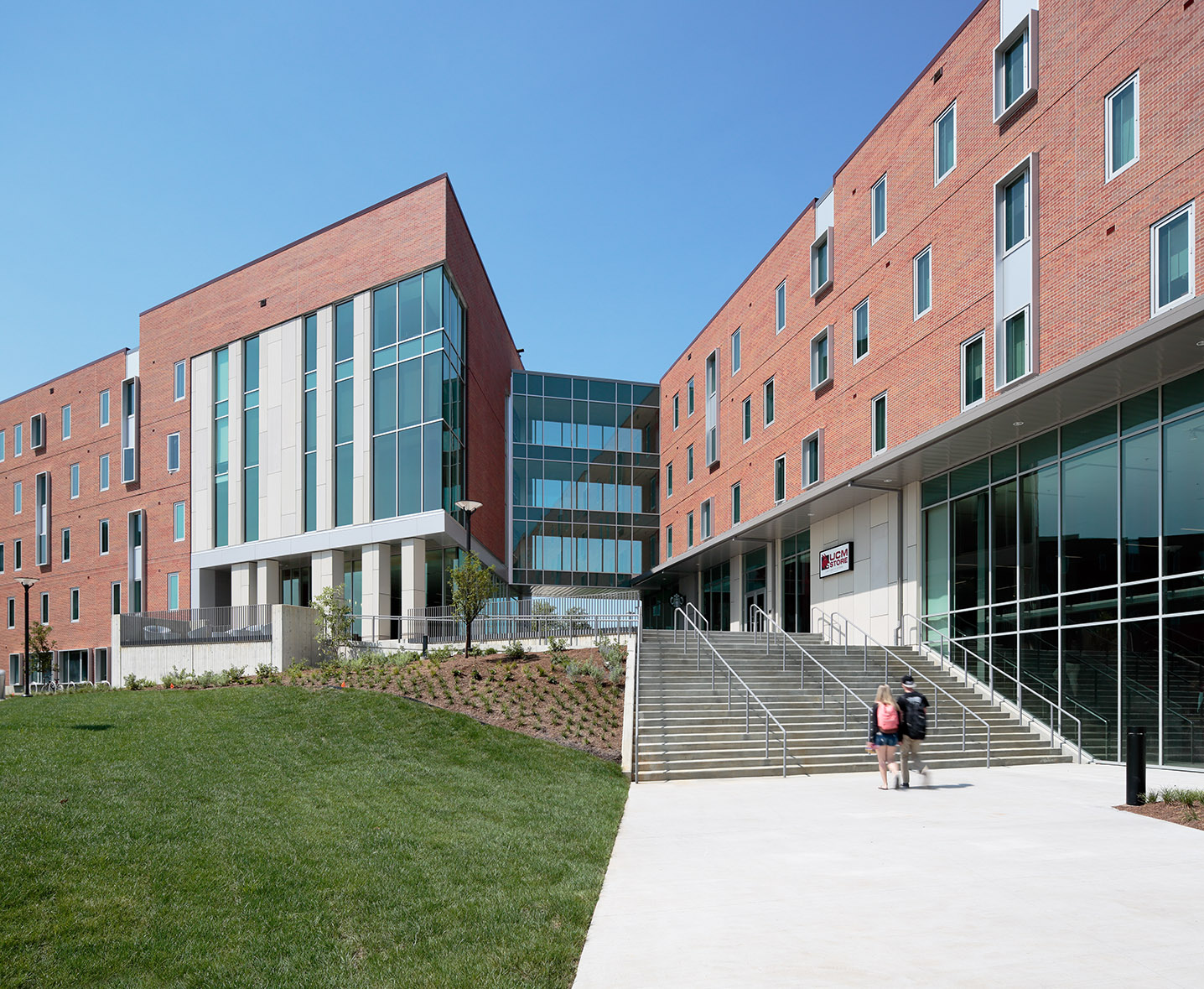Your guide to project delivery methods in construction
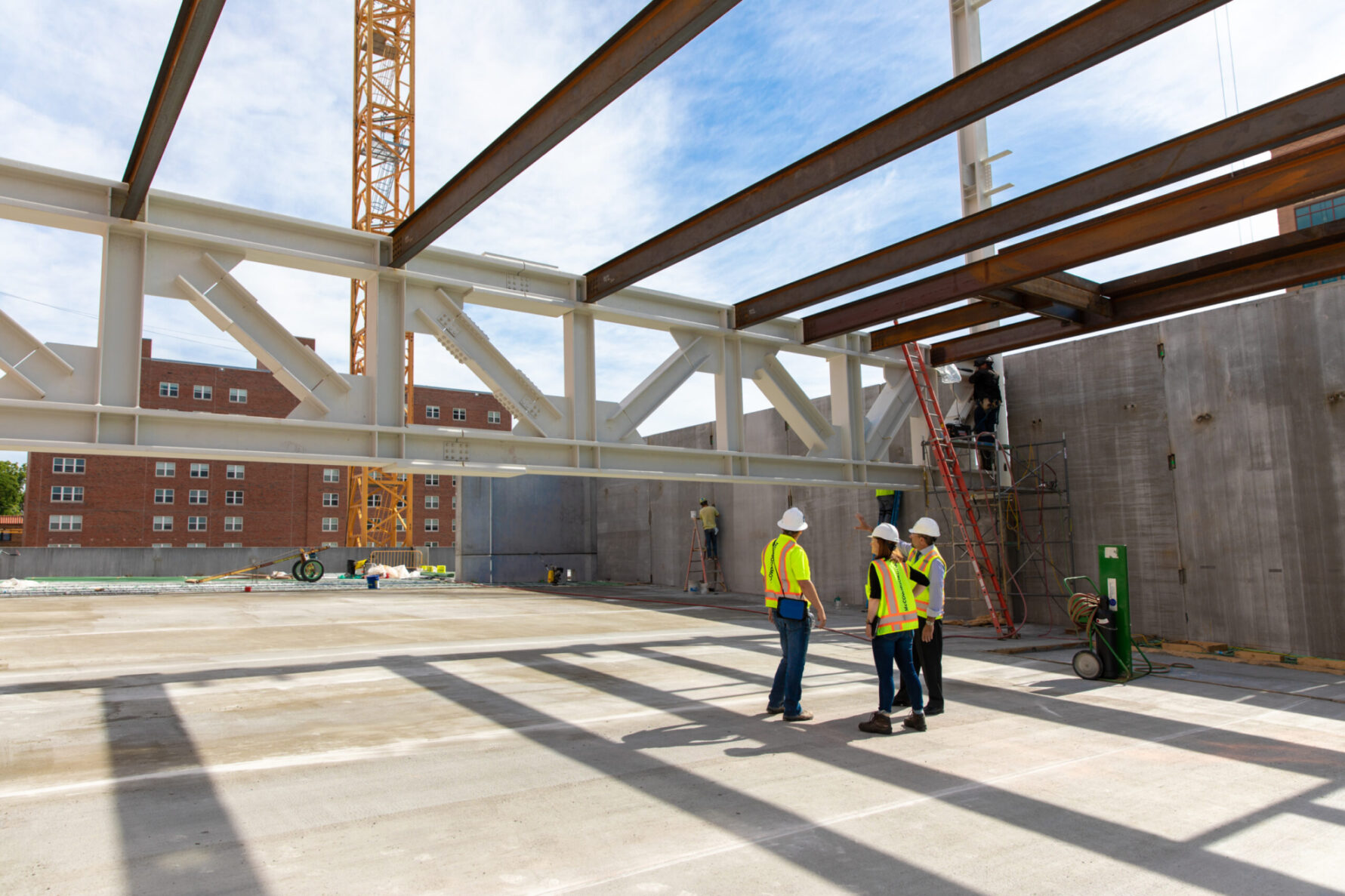
The project delivery method you choose for your construction project drives the success of the entire process. Understanding the different construction project delivery methods gives a great foundation for exploring which method will help your project succeed. At McCownGordon Construction, our expertise allows us to perform on any project delivery method, and we’re happy to lend that expertise to project owners.
Below, we’ve laid out quick considerations to help you when choosing between construction project delivery methods.
What to consider when reviewing delivery methods
Project success hinges on many factors, delivery method included. Some project methods work for many types of projects, others are more specialized. We usually recommend owners pay attention to the following considerations:
Regulations: You should always do your own research to ensure you’re working within set guidelines, and our team is happy to provide guidance.
Budget: Budget is one of the major factors in any project decision, including delivery method. Not only the amount of your budget, but where the funding is coming from (whether private or public) matters.
Schedule: Time constraints matter when choosing construction project delivery methods, as some will lead to breaking ground earlier than others.
Complexity: The complexity of your project factors into how well each delivery method will perform.
Owner expertise: If you’ve got a solid basis of experience as an owner, you may be willing to accept more risk than those without experience, this impacts your delivery method.
Keep in mind there are four types of project delivery methods most commonly used: Design-bid-build, construction management at risk, design-build and integrated project delivery. Generally, all except design-bid-build are considered collaborative project delivery methods.
Your guide to project delivery methods in construction
When it comes to your project, it’s not simply about the outcome—how you get there is just as important. Choosing the right path will not only guide you through the process, it will also drive your project toward success. Understanding the ins and outs of different project delivery methods in construction helps owners of all types of building—whether it’s manufacturing, corporate, K-12 education, higher education, healthcare or civic.
Before you dive into your new construction plan, it’s important to explore which project delivery method will work best for you. However, understanding the different methods proves to not always be an easy feat, especially if this is your first go-round. Fortunately, our team at McCownGordon Construction has all the answers you need.
Our experts compiled some of the most important information to consider when you’re determining the right project delivery method for your construction project. But, at the end of the day, we are always here to help you decide which plan will promote the best outcome based on your specific project needs. .
Read on to learn about each method, which projects they work best for and how each will impact the team members involved.
Delivery Methods Comparison and Analysis →
Why are project delivery methods important?
Project delivery methods are important because they define the factors that contribute to your project’s success. These factors include:
- Budget and funding requirements
- Owner expertise
- Time and schedule constraints
- Project complexity
- Resource availability
When a delivery method complements and fills in holes left from those factors, you reach the optimal process for your construction project. The goal is to maximize your budget, reduce risk for all parties involved, overcome potential problems and meet the owner’s needs.
With that in mind, let’s go through the common project delivery methods you can choose from.
Download: Project Delivery Method Comparison
Design-bid-build project delivery
Two big questions you should ask when considering design-bid-build are: “how complex is my project?” and “how much collaboration do I require?” If your project is less complex without the need for much collaboration, then this project delivery method could work for you.
In this case, the owner hires an architect to create a design, and then puts that design out for bid. From there, construction general contractors evaluate the design and return a price. Then, the owner evaluates the bids and selects their construction firm based on the lowest price.
Once the general contractor is hired , construction begins. As a result, the design process is completely separate from the construction process, which doesn’t allow for preconstruction efforts where the construction and design teams collaborate to determine solutions in the best interest of the owner.
What are the main benefits of design-bid-build?
- A traditional means to an end
- Puts the owner in control
- Each associated party has their own contract
- Able to choose the lowest price
Are there drawbacks to design-bid-build as a project delivery method for construction?
- Expenses could arise if there are unforeseen construction issues
- If bids are out of budget, the process has to restart
- May not get the highest quality contractor if based on price alone
- Does not promote a collaborative environment
The final takeaway
The design-bid-build method typically works for simpler projects under an owner who has a strong grasp of the design and construction process. Some construction projects that are straightforward may benefit from a more price-based method.
Keep in mind that since architects/engineers won’t be in contact with the construction team, the owner will be in charge of bridging that gap. Also the process may take longer, because construction won’t begin until design is fully complete.
Construction Management at Risk (CMR)
If you’re an owner looking for a more collaborative approach that leverages construction expertise, the construction management at risk project delivery method could be a good option. In this case, an owner hires a construction manager (CM) who works collaboratively with the architecture/engineer teams throughout the design and construction process. The CM also works within a guaranteed maximum price (GMP), so even when changes arise, they are often resolved within the established price.
The CM gives the owner insight and advice on budget, cost estimating, scheduling and design. As a result, the owner has a better understanding of the project timeline and why the CM chooses certain trade partners.
Keep in mind that it’s the owner’s responsibility to choose a CM that will help guide them toward the right direction. This means, owners must consider a CM’s experience. If you’re an owner, the goal is to find a manager who has a large portfolio of projects that match your own project. You don’t want to choose someone who is playing the guessing game. That could lead to more risks, more mistakes and a longer project timeline.
What are the main benefits of construction management at risk for project delivery?
- Owner gains help from a team with more expertise
- Creates a collaborative culture from start to finish
- Construction may overlap with design, which may cut down the timeline
- Owner can choose a CM based on price and qualification
Are there any drawbacks to choosing construction manager at risk?
- You may have to go through multiple design options
- Design changes after construction starts are the owner’s responsibility
- May be hard to know if the established GMP is reasonable for the project
The final takeaway
If you have a project with a large undefined scope, crave more collaboration throughout the process or want to have an idea of the cost before design is complete, seeking the help of a CM could greatly help you navigate through the process. Plus, if you have timeline constraints, the CMR can provide the focus you and your team need to get the work done faster.
The CMs also hold the contracts for any trade partners they bring in. This project delivery method allows for more collaboration than the design-bid-build method, but successful collaboration is dependent on how well the CM communicates.
Integrated Project Delivery (IPD)
Integrated Project Delivery is one of the most collaborative project delivery methods. All parties—owners, construction managers, architects and engineers, and major trade partners—enter into a joint contract. That means the risks and even potential cost savings are spread evenly, relieving the owner of some responsibility. As a result, the process is more open, transparent and allows for greater creativity because everyone benefits equally.
Why we recommend integrated project delivery methods for construction
Binds the commitment of the team
The design and construction teams enter into one contract with the owner and commit to the project budget and timeline up-front. This means they are all invested together and working towards the same goal. A key benefit is that from the beginning, the team understands what constitutes a successfully completed project.
Establishes framework for all stakeholders to best achieve overall project goals
Because the teams are working together from the beginning of the project, the team collaborates on the overall project from preconstruction through completion. This gives full transparency during preconstruction with all team members and ensures they all understand the project scope. With the alignment of goals early on, it gives the owner the tools to make sound judgment calls and reduces the stress of decision making.
Creates a culture of collaboration from the beginning, eliminating knowledge dumps
This shared culture of focusing on clear goals and the same vision for success speeds the pace of the project. You don’t want your project to stop while waiting on feedback from your team, or to stall because of poor communication. IPD emphasizes collaboration at every stage to keep everyone on the same track.
Centers team on transparency and trust
To truly have effective collaboration, the team must be guided by trust and transparency. Open communication is welcomed. This environment sparks new innovations and the ability to rely on each other’s strengths for the betterment of the project.
Through the transparency of all team members, hidden agendas and costs evaporate. Throughout each stage of the project, everyone involved knows where the project stands and where the project is heading.
Shares risk and reward
With shared risk and reward the team truly relies on each other and pushes each other for success. The encouragement for a timely, cost-effective project isn’t coming from one member of the project team, but from the contracted team as a whole. They keep each other accountable throughout the entire project and encourage the best building experience across the board. This encouragement from all team members typically helps reduce the project cost.
Breeds innovative, timely and cost-effective ideas
Through shared risk and reward, the team encourages open dialogue and innovative thinking: “How can we put our teams together to come up with the best solution?” “As a team, how can we make this project better than believed possible?”
The team uses each other’s strengths, fills in where others are less skilled or knowledgeable and truly becomes one combined entity that works to bring together the best value for the project. Not only does the owner benefit in the end, but the project team does as well.
Leveraging this collaboration and sharing of knowledge allows the team to better realize their highest potential while expanding the value they provide for the owner.
These benefits can’t be found through other methods. No other process gets committed buy-in from all the teams at the beginning stages of the project. With the shared risk and reward, the teams work harder to collaborate and come up with the best innovative, value-driven ideas.
Starting in preconstruction, the team, in order to successfully complete the project, must continually have open, transparent communication throughout, with one another and the owner. The IPD process wouldn’t work without the bound commitment of honesty, collaboration and trust between all parties.
What to look for when hiring a construction manager for your IPD project.
Design-Build (DB)
The design-build delivery method reduces the number of owner contracts, meaning the owner hires a DB entity to do both the design and oversee construction. Since design, engineering, and construction are under the same contract, it allows more flexibility within the process and a greater collaborative environment.
Most of the time, a DB method will include more than one company, especially if trade partners become involved. This is another project delivery method that can work well around a tight schedule. By starting construction before design is complete, this method can shorten the overall project duration (this is also true for CMAR and IPD).
Why do many projects use design-build project delivery?
1. Design-build delivers projects faster
A major advantage of choosing design-build in the construction landscape is the fact that your project is completed faster, because designing and building are done concurrently. This allows construction to provide feedback to architects regarding constructability, cost and time. Architects, in turn, provide the construction team with progress drawings and information. This exchange of information makes it easier for the entire team to quickly understand potential changes in the plans further along in the process.
Having a single point of contact also streamlines the project. Collaborative problem-solving happens naturally when the entire team—including the owner, designer and contractor—address changes together. The Design-Build Institute of America (DBIA) performed research showing, compared to design-bid-build, design-build projects are delivered 36% faster during construction and 102% faster over the life of the project.
2. Design-build saves money
DBIA research from 2018 showed design-build projects cost an average of 1.9% less per square foot compared to construction manager at risk, and 0.3% less when compared to design-bid-build. Additionally, design-build projects average 2.4% less cost growth than comparably scoped projects using construction manager at risk and 3.8% less cost growth compared to design-bid-build projects.
The team chemistry between owner, designer and builder drives that reduction in cost per square foot along with open book contracting terms and lower initial contracted unit costs. The reduction in cost growth relates back to those same factors, as well as the earlier involvement of the builder. Having the contractor price material as the design team plans contributes to cost reduction. We provide additional options so the owner can select products that have the same look, feel and quality for a lower price.
3. Design-build projects give opportunities to innovate
When FMI surveyed project owners, respondents identified the top benefits associated with different project delivery methods. For design-build, “more opportunities to innovate” was strongly associated as a benefit, along with the “ability to fast track projects.” Traditional delivery methods lack the same collaboration and innovation opportunities developed in design-build delivery.
4. Design-build reduces risk for owners
The nature of a single contract between the owner and the design-build entity transfers the risk onto the design-build entity’s shoulders. In addition to this actual transfer of risk, the collaborative nature of design-build project delivery reduces risk through open communication and common goals.
The final takeaway
Design-build may not be for everyone, but it opens the door for you to unload some risk associated with the project. With collaboration, the design-build delivery method can help reduce the occurrence of mistakes and conflicts that could deter the on-time completion of your project.
Keep in mind that even though a design-build entity can become involved earlier on, you still want to have clear goals so that your design-build can drive your project to meet those goals. The McCownGordon team excels at early collaboration that helps clarify your vision to define what you want to accomplish.
Public-Private Partnerships
If you’re building new community facilities, funding can benefit from alternate options. It’s become more common for mutually beneficial partnerships between public entities and private developers to provide those financing options.
From national projects for the federal government to local municipalities looking to enhance their communities’ amenities, our team has experts that can help you navigate this process right from the start. Simply stated, a public-private partnership is a cooperative venture between a public, tax-supported entity and a private business. A public-private partnership is a supplement to project delivery methods in construction. It is a funding mechanism that can be leveraged to fund virtually all projects no matter what the delivery method: design-build, traditional design-bid-build or other.
Key to the public-private partnership funding method is an available revenue stream that is used to compensate the private partner in the project. The popularity of public-private partnerships in higher education projects has been largely driven by the revenue generated from student housing. Indeed, P3s have worked so successfully in student housing that they are expanding into other types of campus infrastructure projects. These include parking garages, recreation centers and renewable energy initiatives.
Institutions of higher education primarily are designed for teaching and research. The work of managing major redevelopment is not part of the skillset so bringing in a private company with development expertise makes sense. It greatly reduces the pressure on campus staff to take on a major effort that is outside of their core business. Outside expertise can also result in lower construction costs, expedited timelines and better, more effective buildings that capitalize on the latest academic trends.
The growing interest in P3s stems from tighter budgets, greater project complexity, seeking better value for money, the desire to leverage private sector expertise and shifting public sector priorities.
How to know which project delivery method works best for a project
There are several important project considerations that are directly impacted by the delivery method. These considerations include the complexity of the construction project, the availability of owner resources to help manage a project, the owner’s level of expertise with design and construction processes, necessary schedule constraints, budget and funding requirements and an owner’s risk tolerance.
Download our project delivery method guide
What are the goals and objectives for the project?
Project owners generally have the same goals when completing a project: construction at a reasonable cost, of the highest quality, and completed within the shortest period of time.
However, some goals may take precedence over others. For example, the speed of implementation may be more important than cost on certain projects. For others, maintenance and life-cycle costs may be the primary concern. Owner control of the design may be important for some, while, for others, lowest initial construction cost is paramount.
What types of goals and objectives often weigh highest when choosing project delivery methods for construction?
- Amount of risk you want to manage
- Accelerated and/or fastest timelines
- Best value for life-cycle cost of your building
- Control over design decisions
- Early contractor engagement and level of early collaboration desired
- Early cost guarantees
- Impacts on financing and third party costs
- Limit demands on your resources
- Limit impacts on your current operations
- Limit number of contractual entities and points of contact
Does the Project Have Any Challenges?
When selecting the best project delivery method, rank your goals, objectives and challenges and match them to the strengths and attributes of the various project delivery methods. For example, some projects may be challenged by cash-flow restrictions or a renovation project may have ongoing operational needs during construction. The analysis is not so much a question of advantages versus disadvantages, but rather to select the delivery method with the strengths and attributes that best align with the goals and needs of the project.
The project schedule can be greatly impacted by the selected delivery method. Due to the ability to overlap design and construction activities, the design-build, integrated project delivery and construction manager at risk delivery methods can shorten the overall project schedule compared.
At McCownGordon, we highly recommend that owners speak with one of our experts to understand which delivery method could benefit them most. We can also help you understand the regulations surrounding your project that could limit your choice. At the end of the day, we want you to have the best construction experience at the best value.
We build using a variety of project delivery methods with your goals in mind, and we work hard to understand why you want to build a structure to guide you on the right path.
What should you do after choosing your delivery method?
Once the selection of a delivery system is made, it is important the owner takes additional and continuing steps to maximize the chances of its success:
- Effectively communicate to all team members (architects, engineers, CMs, contractors and consultants) the goals, objectives and issues that drove the selection of the delivery system. It is important they understand and commit to the owner’s expectations. Once the selection of a delivery system is made, it is important the owner takes additional and continuing steps to maximize the chances of its success:
- Ensure the terms and conditions of all contracts reflect the project goals, objectives and expectations and memorialize all related agreements. For example, if changes during construction are anticipated, be sure the contract defines how they will be managed, and their cost and schedule impact minimized.
- Consider legal assistance experienced in construction matters for crafting contract language.
- Commit to the appropriate level of owner involvement, e.g. active involvement with timely and informed decision-making to not delay or impact the project. Conversely, avoid imposing owner changes or controls on DB contracts.
- Assess potential risks and plan how to manage the overall program, e.g., internally or via a program management consultant.
- Recognize that disputes over scope, quality and other issues may still arise. Define how disputes will be handled so cost/schedule impacts are minimized.
Learn more about project delivery methods at McCownGordon Construction
Download our project delivery method guide
McCownGordon is prepared to provide the best project delivery methods for your construction project in the Midwest and across all regions we serve. Collaborative project delivery methods lead to optimum results for nearly any project through reduced risk, early collaboration and balanced participation.
At McCownGordon, our team maintains a customer-focused mentality, allowing us to meet or exceed even your highest expectations. Dedicated to promoting integrity, performance and relationships, it’s our people and values that truly make the difference.
Our customers aren’t simply another project; they’re an extension of our team and community. Together, we don’t just build—we bring creative visions to life. From first thought to final nail, we deliver quality work to ensure our builds stand above the rest.
We have three regional offices around the Midwest—Kansas City, Manhattan and Wichita in addition to our newest location in Dallas-Fort Worth, Texas. Call us at 888-304-4929 or use our free online quote tool to start building today.
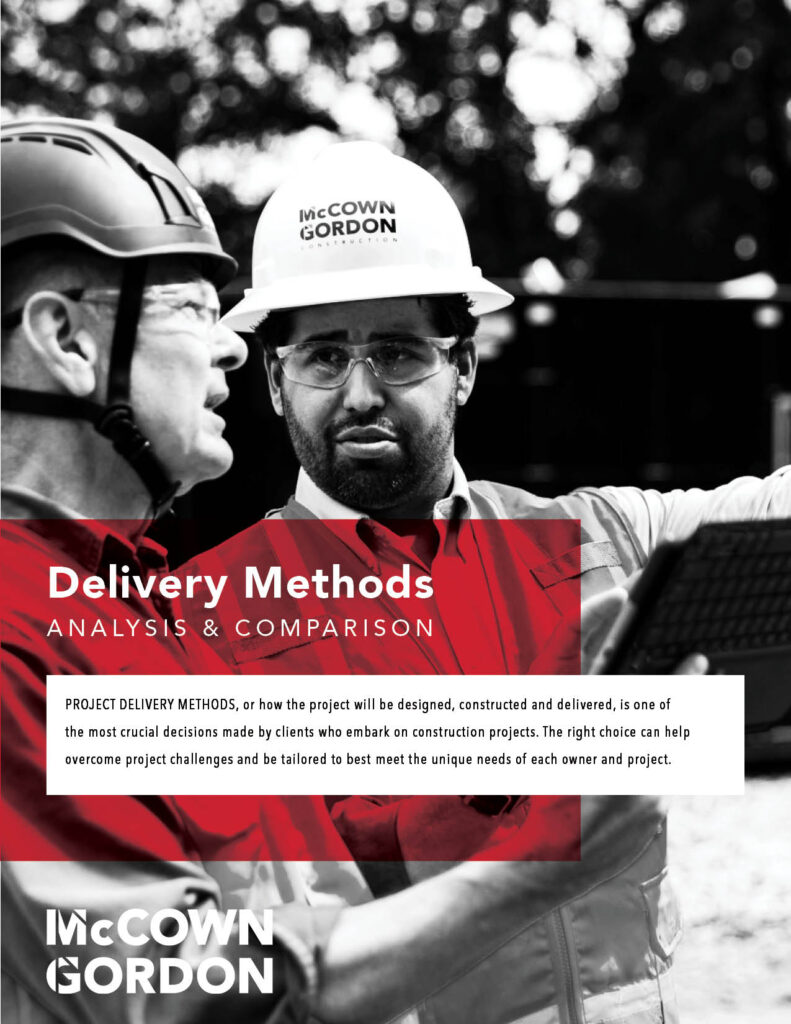
COMPARING THE BENEFITS OF EACH PROJECT DELIVERY METHOD
Choosing the best project delivery method for your construction project can be overwhelming. Our experts evaluated the benefits of each delivery method to help you make an informed decision when planning your next construction project.

